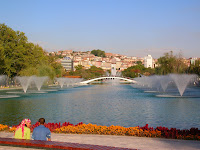 Sunday 20 December: Portuguese enclave until 1961 the island retains tax-free status so local spirits, beer, port and even wine is relatively inexpensive. Surrounded by the strict Hindu state of Gujarat which operates prohibition laws it's a popular destination for locals and visitors alike, especially at holiday times.
Sunday 20 December: Portuguese enclave until 1961 the island retains tax-free status so local spirits, beer, port and even wine is relatively inexpensive. Surrounded by the strict Hindu state of Gujarat which operates prohibition laws it's a popular destination for locals and visitors alike, especially at holiday times.Set in the Arabian Sea, Diu has an imposing Portuguese fort with huge bastions, a double moat and range of bronze and iron cannons. Not quite a tropical paradise, the beaches are sandy, the town's quiet, hassle-free and the locals are friendly - Sunset beach the most popular with foreign travellers.
Dinners mostly at O'Coquero Music Garden Restaurant which specialises in Portuguese fish dishes. No Turkey this year but delicious king fish, squid, sea eel, tuna and pomfret served plain-fried or in a variety of sauces. Midnight Mass at the elaborate, whitewashed St Paul's, billed by the tourist board as an annual festival, was a joyous affair with music and song.
Celebrated the New Year at O'Coquero's with Canadian-Gujarati hippy guy, elf-like Bavarian redhead Sonja, hot Swedish Kristina, a young Argentinian guy heading down to Kerala, shaven-headed Paul, a Belgian cyclist spending three-and-a-half years peddling his way around the world to Alaska and, of course, nice to see, once again goaty-bearded Kevin from Tullamore.
Photos of Diu.
Friday 1 January 2010: Great to be on the road again - 7:30 pm double-decker sleeper bus with beds (37th mode of transport) for the 11 hour ride to Ahmedabad to catch the 11:55 pm Howrah Express sleeper to Jalgoan on Saturday.

























 Thursday 17 September: Boat harbour
Thursday 17 September: Boat harbour


















